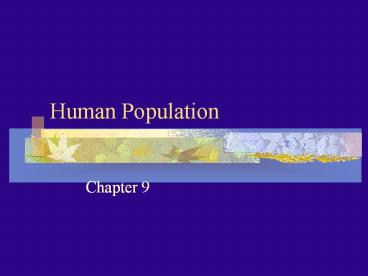Human Population - PowerPoint PPT Presentation
Title:
Human Population
Description:
Human Population Chapter 9 Population success Thailand had uncontrolled growth 3.2% in 1971 According to the rule of 70, how long until their population doubles? – PowerPoint PPT presentation
Number of Views:190
Avg rating:3.0/5.0
Title: Human Population
1
Human Population
- Chapter 9
2
Population success
- Thailand had uncontrolled growth 3.2 in 1971
- According to the rule of 70, how long until their
population doubles? - Thats right 21.9 years, and yes, that is really,
really fast - Thanks to some intervention and education, a
major tragedy was averted
3
Good job Thailand
- How did they do it
- Government supported family planning
- High literacy rate among women
- Increase in economic role of women
- Better health care for mothers/children
- Responsive public
- Flexible government to try different approaches
- Cooperation of cultural/religious leaders
4
Population change
- (Birth immigration) (death emigration)
- ZPG
- World growth rate as of 2000 is 1.35
- Down from 2.2 in 1963
5
Moving in the right direction, but
- Slower does not mean slow
- We are still scheduled to double in 52 years
- We are adding 82 million people per year, roughly
a New York every month, a Germany every year, a
united states every 4 years - How will this affect resource use?
6
Lets have a baby
- Replacement level fertility number of children
to replace parents 2.0 in theory, but most
developing countries it is 2.1 to as high as 2.5
due to infant mortality - Total fertility rate average number of children
women have. Currently 2.9, which means in 150
years there will be 296 billion people !!!!
7
World
5 children per women
2.9
Developed countries
2.5
1.5
Developing countries
6.5
3.2
Africa
6.6
5.3
Latin America
5.9
2.8
Asia
5.9
2.8
Oceania
3.8
2.4
North America
3.5
2.0
Europe
2.6
1.4
Fig. 11.7, p. 241
1950
2000
8
Key factors for TFR
- Children as labor force
- Urbanization
- Cost of raising and educating
- Education and employment for women
- Infant mortality rate
- Average age at marriage
9
Factors affecting death rates
- Food supply
- Nutrition
- Medical improvements
- Sanitation
- Drinking water improvements
10
Age structure diagram
- Usually broken into three categories
- Prereproductive 0-14
- Reproductive 15-44
- Post reproductive 45-dead
- The shape of the age structure diagram is useful
in determining future growth
11
Male
Female
Male
Female
Rapid Growth Guatemala Nigeria Saudi Arabia
Slow Growth United States Australia Canada
Fig. 11.16a, p. 247
Ages 0-14
Ages 15-44
Ages 45-85
12
Male
Female
Male
Female
Zero Growth Spain Austria Greece
Negative Growth Germany Bulgaria Sweden
Fig. 11.16b, p. 247
Ages 0-14
Ages 15-44
Ages 45-85
13
Demographic transition
- As countries become industrialized their death
rates decrease and their population grows - Later their birth rates decrease and population
stabilizes
14
Stage 1 Preindustrial
Stage 2 Transitional
Stage 3 Industrial
Stage 4 Postindustrial
Birth rate
Death rate
Total population
Low growth rate
Increasing Growth growth rate
Very high growth rate
Decreasing growth rate
Low growth rate
Zero growth rate
Negative growth rate
Fig. 11.26, p. 255
15
Demographic transition
- Preindustrial
- Stable population high birth/death rate
- Poor living conditions
- Low per capita income
- Poor sanitation
- High infant mortality
- Low use of birth control
16
Demographic transition
- Transitional
- Industrialization begins
- Increased food supply
- Better sanitation/healthcare
- Infant mortality drops sharply
- Birth rate still high (culture)
- Population grows rapidly (2.5-3 a year)
17
Demographic transition
- Industrial
- Industrialization is widespread
- Per capita income is up
- Birthrate decreases sharply
- Birth rate approaches death rate
- Slow population growth
- Most developed countries are in this phase
18
Demographic transition
- Postindustrial
- Birth/death rates are equal
- Population stabilizes or even drops slightly
- Most of Europe is here
- 85 of the world still needs to reach this stage
19
India
China
Percentage of world population
16
21
Population (2000)
1 billion
1.3 billion
Population (2025) (estimated)
1.4 billion
1.4 billion
Illiteracy (of adults)
47
17
Population under age 15()
36
25
Population growth rate ()
1.8
0.9
Total fertility rate
3.3 children per woman (down from 5.3 in 1970)
1.8 children per woman (down from 5.7 in 1972)
Infant mortality rate
72
31
Life expectancy
61 years
71 years
Fig. 11.29, p. 257
GNP per capita (1998)
440
750
20
Infrastructure
- How will the increasing population affect each
nations infrastructure? - Homes
- Jobs
- Transportation
- Food supply
- Taxes
- Schools
- Energy needs
- Resource needs































